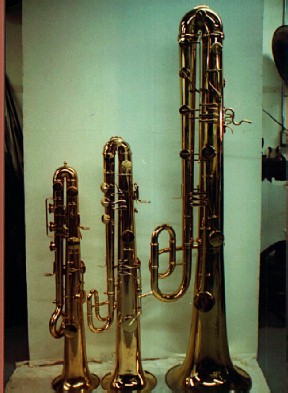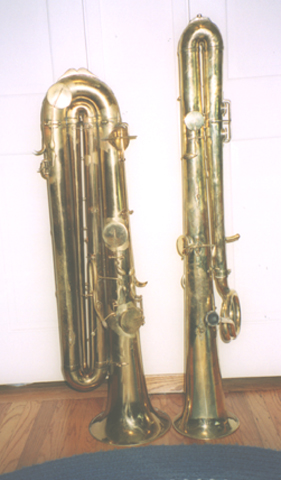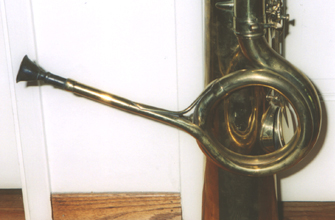| The ophicleide is part of the family of keyed bugles
invented by Hallary in the early 1800's. While the soprano members
of the family (in Eb, C, and Bb, at least) were made in a single coil,
in the shape of a bugle, the larger members were made upright. The
first instruments were made with 9 keys, while later models were equipped
with 11 or 12.
The name "ophicleide" means "keyed serpent", and in fact the ophicleide was developed as an improvement over the serpent. The serpent is difficult to play and has a soft timbre. Its tone holes are arranged essentially where one can reach them, rather than where they have the best effect acoustically. Hallary revised the entire concept, making the bore of metal (rather than the serpent's wood), positioning 9 tone holes in approximately correct locations, and covering the large holes with padded keys. Additional keys were added later to improve particular notes. However, the keys are not arranged to make sense to woodwind players: keys reach from the tone hole to the nearest finger (or thumb). See the online ophicleide fingering chart. Learning the fingerings is more like learning valve combinations. The ophicleide was made in a variety of sizes, from the alto size ("quinticlave") in Eb and F, and the bass in C and Bb, to the rare contrabass in Eb. The size most often found today is the bass, having a range corresponding roughly to the bassoon. The instruments at right are modern-day recreations of
bass ophicleides in C and Bb, and a contrabass ophicleide in Eb, by Robb
Stewart (Robb Stewart Brass Instruments, 140 E. Santa Clara St. #18, Arcadia,
CA 91006, 626-447-1904). I understand there is a waiting list....
|
 |
 |
The instrument at right is my Halary ophicleide (Bb bass),
shown here with my reed
contrabass. A detail of the crook is shown below
For more information, see also the Serpent Webpage. |
| Back to the Compendium
Copyright ©1999-2000 by Grant D. Green |
For more pictures, see |
